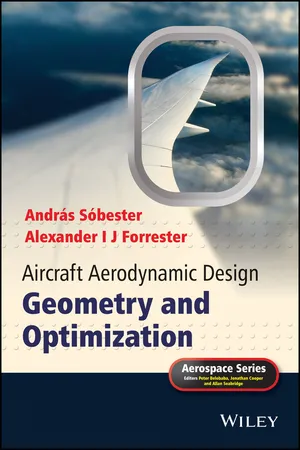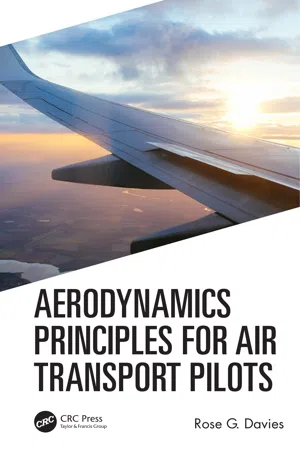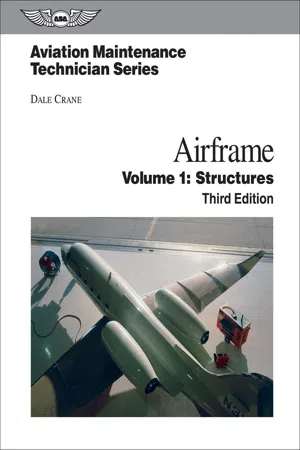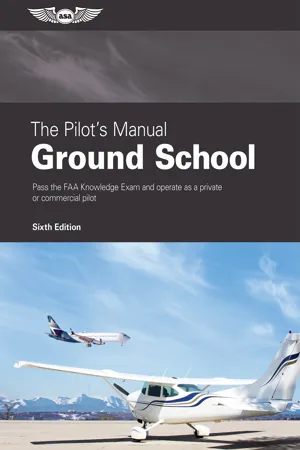Technology & Engineering
Aerofoil
An aerofoil is a shape designed to produce lift when air flows over it. It is commonly used in the design of aircraft wings and propeller blades. The shape of the aerofoil causes the air pressure above it to be lower than the pressure below, resulting in upward lift.
Written by Perlego with AI-assistance
Related key terms
1 of 5
6 Key excerpts on "Aerofoil"
- eBook - ePub
Aircraft Aerodynamic Design
Geometry and Optimization
- András Sóbester, Alexander I J Forrester, Alexander I. J. Forrester, Peter Belobaba, Jonathan Cooper, Allan Seabridge, Peter Belobaba, Jonathan Cooper, Allan Seabridge(Authors)
- 2014(Publication Date)
- Wiley(Publisher)
5 Aerofoil Engineering: FundamentalsThe concept of an Aerofoil (‘airfoil’ in the USA) has always been pivotal to humankind’s attempts to engineer flying machines, and writings associated with it probably account for a greater percentage of the aeronautical engineering literature than any other single notion. ‘The Aerofoil section is the quintessence of a wing or lifting surface and, as such, occupies a central position in any design discipline relating to fluid mechanics, from animal flight through marine propellers to aircraft’, notes Lissaman (1983).The first and, possibly, last comprehensive monograph on the subject is a 700-page tome by Abbott and von Doenhoff (1959) (Dover’s 1959 reprint is the best-known edition today, but the original was published in 1949). Their ‘Theory of Wing Sections’ is still a valuable reference today, in spite of the fact that it pre-dates by a long way the modern idea of Aerofoil design based on numerical performance analysis.Here, we shall make no attempt at an updated version of their book, as a similarly comprehensive work today would run to many thousands of pages. We concentrate instead on an aspect of Aerofoil design that is most germane to the subject of this book: geometrical descriptions of Aerofoils that enable parametric optimization studies. This chapter sets out some of the fundamental Aerofoil-related ideas that any aerodynamics engineer should be familiar with, followed by a discussion of two categories of geometrical formulations of interest in analysis-driven aerodynamic design: Aerofoil families (Chapter 6) and generic parametric formulations suitable for Aerofoil description (Chapter 7).5.1 Definitions, Conventions, Taxonomy, Description
An Aerofoil section is the intersection of a lifting surface or a streamlined fairing and a plane. The term in itself gives limited indication of the positioning of the cutting plane. Sometimes this is taken to be parallel with the plane of symmetry of the pair of wings, tailplanes, canards, and so on (this is generally the same as the plane of symmetry of the aircraft). In the case of swept lifting surfaces and/or those with significant dihedral (we will define these concepts in detail in Chapters 8 and 9 respectively; for now, we simply note that we mean that the leading edge is no longer a straight line perpendicular to the symmetry plane), the cutting plane may be orthogonal to the leading edge instead. - Available until 8 Jun |Learn more
- Rose G Davies(Author)
- 2020(Publication Date)
- CRC Press(Publisher)
The airflow over a finite wing is three-dimensional. A finite wing is a real wing. Wings on existing aircraft are generally finite wings. Theory of Lift The main function of an Aerofoil is to produce lift. The airflow around an Aerofoil with a positive angle of attack can be observed with a pattern as shown in Figure 4.6 (a). The streamlines in Figure 4.6 (a) show that airflow speed is higher over the upper surface than the airflow under the lower surface, and there is prominent downwash at the trailing edge, and upwash at the leading edge. The air pressure around the Aerofoil is not uniform as it would be in the free-stream. There is a pressure distribution around the Aerofoil, and Figure 4.6 (b) shows the distribution of Δp = p – p fs around the Aerofoil. The negative sign “−” means that the local pressure is less than the free-stream pressure, and the positive sign “+” means that the local pressure is greater than the free-stream pressure. Overall, the pressure on the lower surface of the Aerofoil is higher than that on the upper surface, so we know, in principle, the Aerofoil produces lift. There are various theories of lift which have been developed to quantify the lift. They all depend on the descriptions or the assumptions about the airflow field around the Aerofoil. Some of these are simple and relatively easy to understand, but operate under very strict assumptions, for example, the Bernoulli theorem. Some of them are very comprehensive with detailed mathematical description of the fluid field around Aerofoil, for example, 3-D computational simulations of Navier–Stokes equations - eBook - PDF
Life in Moving Fluids
The Physical Biology of Flow - Revised and Expanded Second Edition
- Steven Vogel(Author)
- 2020(Publication Date)
- Princeton University Press(Publisher)
According to F. W. Lanchester (1868—1946), an airfoil is a device that can produce circulation in its vicinity without itself actually rotating. Just how can this happen? The fact that the lift for an airfoil is proportional to the square rather than the first power of the free- stream speed suggests that the circulation itself must be proportional to the speed of the oncoming airstream. If so, then somehow the shape and orientation of the airfoil must interact with the oncoming air to produce 1 All of the material to follow applies to lift production in water as well as air. Using "airfoil," "airstream," "wind," and so forth should be regarded as just a linguistic conve- nience or ancient prejudice of the author. 230 LIFT, AIRFOILS, GLIDING, SOARING leading e 4 g e ^ oncoming ^ ^ wind ^ — L cross section or profile chord, c 7^iE ^——___^ ^ of attack top or plan view area, S — — — — trailing ^ chord, c 1— 1 thickness c j lift resi , / lltant force 1 aerodynamic forces oncoming wind span, b FIGURE 11.1. The terminology for lift-producing airfoils. the circulation—the faster the air, the more intense the circulation. A rotating cylinder, of course, generates its circulation quite independently of any translating airstream. What determines the value of the circulation and hence the lift was first realized by Joukowski (or Zhukovskii) early in the present century. He pointed out that for an airfoil with a sharp trailing edge, only one pattern of flow permitted the air to slip off the rear of the airfoil without any discontinuity or without having to turn the sharp corner at the trailing edge. This pattern had to determine the amount of circulation and lift. Pressure might be lower on top than bottom because of the sharp trailing edge and the rapid rearward flow on top—but fluid, with momentum, just doesn't find it feasible to sneak around and relieve the difference. So instead everything else shifts, creating a net circulation, as shown in Figure 11.2. - Arthur Rizzi, Jesper Oppelstrup(Authors)
- 2021(Publication Date)
- Cambridge University Press(Publisher)
8 Airfoil Design Considerations A theoretical airfoil design method enables the design of airfoils that fall outside the range of applicability of available catalogs, the design of airfoils that exactly match the requirements of the application, and the economic exploration of various airfoil concepts. Dan M. Somers, President, Airfoils, Inc. 1 Preamble As assumed by Prandtl’s lifting-line theory, a section of the wing parallel to the free stream can be considered to act independently of the other sections, except for an induced angle of attack varying along the span. The flow over any section is therefore plane with no component along the span. The aerodynamic characteristics of wings of infinite span are accordingly called “wing section characteristics,” “airfoil section characteristics,” or simply “airfoil characteristics,” and they determine the boundary- layer flow and compressibility effects. The study of wing characteristics simplifies by decomposition into two weakly coupled systems – section and planform – which may be considered separately; planform variations were treated in Chapter 3. Even for wings of arbitrary planform and twist, characteristics such as angle of zero lift, lift-curve slope, span loading, and drag for high-speed and cruise conditions can be predicted from airfoil data. This actually works very well at low- and moderate-lift coefficients if no spanwise discontinuities or rapid changes of section, chord, or twist are present, if the wing has no pronounced sweep, and if the wing is of sufficient aspect ratio. It follows that building a knowledge base for airfoil characteristics is an effort well spent. This chapter explains and illustrates the connection between the airfoil geometry and its resulting pressure distribution in low- and high-speed flight. Deployment of slats and flaps increase lift for takeoff and landing, and multielement airfoils demon- strate the effects of these high-lift devices.- eBook - PDF
- Dale Crane(Author)
- 2008(Publication Date)
- Aviation Supplies & Academics, Inc.(Publisher)
The force produced by air moving over a specially shaped surface called an airfoil. Aerodynamic lift acts in a direction perpendicular to the direction the air is moving. airfoil. Any surface designed to obtain a useful reaction, or lift, from air passing over it. Figure 1-2. Conditions of the standard ICAO atmosphere 8 A VIATION M AINTENANCE T ECHNICIAN S ERIES Volume 1: A IRFRAME S TRUCTURES In practical flight conditions, air pressure is measured in terms of altitude rather than inches of mercury or pounds per square inch. The altimeter is an absolute-pressure gage, or barometer, that measures the pressure of the air and indicates the altitude at which that pressure exists. When the barometric scale of the altimeter is set at the standard sea-level pressure, 29.92 inches of mercury, the indication is called pressure altitude. Density altitude, used to determine the amount of lift produced by an airfoil and the amount of power produced by an engine, is found by correct-ing pressure altitude for nonstandard temperature. Bernoulli’s Principle Aerodynamic lift is produced by the relative movement between an airfoil and the air. Air is a viscous fluid: it “wets,” or tends to adhere to, any surface over which it flows. An airfoil like the one in Figure 1-3 is shaped in such a way that the air flowing over its upper surface finds the surface dropping away from it, and it must speed up. The air flowing below the airfoil finds the surface rising into its path and it is forced to slow down. In 1738, the Swiss physicist Daniel Bernoulli explained the relationship between potential and kinetic energy in the air as it flows over an airfoil. Air’s potential energy relates to its pressure, and kinetic energy to its veloc-ity. The sum of potential and kinetic energy in the air is its total energy. - No longer available |Learn more
The Pilot's Manual: Ground School
Pass the FAA Knowledge Exam and operate as a private or commercial pilot
- (Author)
- 2022(Publication Date)
- Aviation Supplies & Academics, Inc.(Publisher)
In addition, it is difficult to construct a thin, flat wing (no strength, no internal structure). Figure 1-15 Airflow can lift a flat plate (but not efficiently). Total reaction No reaction Upwash Downwash Angle of attack Turbulent flow Total reaction Figure 1-16 Examples of various airfoil shapes. A cambered airfoil A symmetrical airfoil Leading edge Trailing edge Trailing edge Leading edge 10 Ground School Aerodynamics A cambered airfoil surface not only generates more lift and less drag compared to a flat plate, it is also easier to construct in terms of structural strength. Airfoils can have many cross-sectional shapes. Airplane designers choose the shape with the best aerodynamic characteristics to suit the role of the airplane. Camber Camber is curvature. Aviation pioneers, such as Wilbur and Orville Wright, experimented with different curved (cambered) shapes and found that the degree of curvature, the point of maximum curvature, and the ratio of thickness to length were critical. Later designers found that the shape of the upper curvature was more important than the lower curvature, and therefore they could have a thicker, lighter, stronger wing with internal storage capacity for fuel and structure with no aerodynamic penalty. Thick wings with a large camber have a good lifting ability, making them suitable for low-speed flight. The position of greatest camber is usually about 30 percent back from the wing leading edge. As camber increases, the airflow path lengthens, resulting in the airflow speeding up, static pressure reducing and lift and drag increasing. Wings with less camber give a better cruise performance but a higher takeoff and landing speed (and distance). Aircraft and airfoil design is a compromise to suit customers’ requirements. Mean Camber Line The mean camber line is the line drawn halfway between the upper and lower surfaces of the airfoil cross-section. This line gives a picture of the average curvature of the airfoil.
Index pages curate the most relevant extracts from our library of academic textbooks. They’ve been created using an in-house natural language model (NLM), each adding context and meaning to key research topics.





